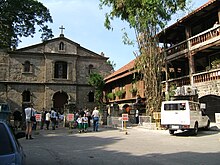Las Piñas Church
| Las Piñas Church | |
|---|---|
| St. Joseph Parish Church of Las Piñas Iglesia Parroquial de San José de Las Piñas |
|

Las Piñas Church with the old convent to the right and St. Joseph's Academy, further right
|
|
| 14°28′52″N 120°58′53″E / 14.48111°N 120.98145°ECoordinates: 14°28′52″N 120°58′53″E / 14.48111°N 120.98145°E | |
| Location | P. Diego Cera Avenue Las Piñas, Metro Manila |
| Country | Philippines |
| Denomination | Roman Catholic |
| History | |
| Founded | 1795 |
| Founder(s) | Diego Cera |
| Dedication | Saint Joseph |
| Relics held | Las Piñas Bamboo Organ |
| Events | International Bamboo Organ Festival |
| Architecture | |
| Status | Parish church |
| Functional status | Active |
| Heritage designation | National Historical Landmark |
| Designated | July 15, 2013 |
| Architect(s) | Diego Cera |
| Architectural type | Earthquake Baroque |
| Groundbreaking | 1797 |
| Completed | 1819 |
| Specifications | |
| Length | 110 feet (34 m) |
| Width | 94 feet (29 m) |
| Nave width | 70 feet (21 m) |
| Number of domes | None |
| Materials | Adobe (volcanic) stones |
| Administration | |
| Parish | Las Piñas |
| Diocese | Parañaque |
| Province | Manila |
| Clergy | |
| Priest(s) | Mario Josefino Martinez |
| Laity | |
| Organist(s) | Armando Salarza |
St. Joseph Parish Church (Spanish: Iglesia Parroquial de San José de Las Piñas), commonly known as the Las Piñas Bamboo Organ Church or simply Las Piñas Church, is the Roman Catholic church of the parish of Las Piñas, just south of the city of Manila in the Philippines. The church is renowned as the house of the Las Piñas Bamboo Organ, a pipe organ made mostly with bamboo pipes. To the right of the church is an old Spanish convent converted into a gift shop and the entrance for observing the organ up close. Also in the church complex is St. Joseph's Academy, a primary and secondary education school established in 1914.
The parish falls under the jurisdiction of the Roman Catholic Diocese of Parañaque. The parish priest of the Las Piñas church is Rev. Msgr. Mario Josefino Martinez, PC, JCD since July 1, 2011.
On November 5, 1795, the Archbishop of Manila assigned Las Piñas, then a small town of farmers and fishermen, to the Augustinian Recollects to establish a new church. Fray Diego Cera de la Virgen del Carmen, a native of Spain, traveled from Mabalacat, Pampanga province and arrived on the town on the day after Christmas of 1795. Soon after, he started building the church made from adobe (volcanic) stones in the Earthquake Baroque architectural style.
...
Wikipedia

